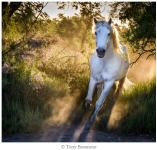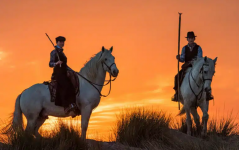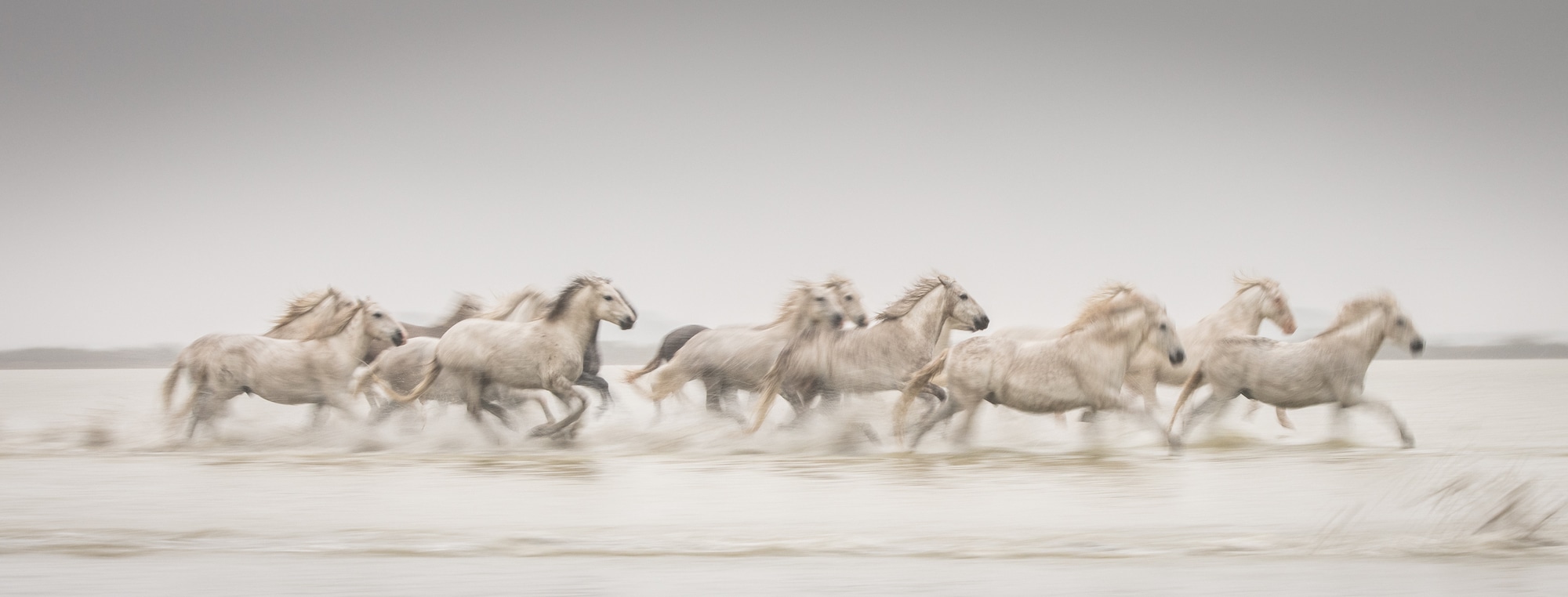Mzkitty
I give up.
Following the Legendary White Horses in Camargue
The Camargue Horse is often called “the Horse of the Sea”. It has inhabited this region in South of France for thousands of years, along with Pink Flamingos, Grey Herons, black bulls, and the many sounds of nature.May 16, 2023

Cavalier et photographe
With fast shutter speeds and long lenses, Tony Bonanno follows the Camargue horses galloping through the water across the horizon in a colorful blur of swift beasts in motion, water flying from their hooves. On other occasions, risking danger, he crouches behind a small hill as the gardians drive the horses directly at him for chilling close-ups while the herd thunders past him. His exhilarating photographs of the white horses of the Camargue artfully represent the beauty of their movement and the nobility of their elegant and ancient stature.
Tony Bonano’s portraits of the Gardian culture are no less works of art: stirring portraits of the men and women who care for the herds, details of the tools of their trade, and exquisite photographic depictions of their charming homes and barns.
“The Camargue horse is considered a primitive breed and probably evolved in the Camargue Delta over thousands of years”, says the photographer. “Most Camargue horses are semi-feral. They live in small groups on large expanses of land managed by the Gardians and their herders. They spend much of their life in wetlands and marshy environments. They are often called the “Horse of the Sea”.”
At full speed with no obstacles
Today’s Camargue horse probably wouldn’t exist without the Gardians, and the more I learned about the Gardians, the more fascinated I became. The Gardian culture, the tradition, and the passion I observed is genuine. It is a unique lifestyle that has existed since the 16th century.
For generations, the Gardians have worn the same kind of hats and vests, managed their herds with trident tipped staffs, used the same type of saddle and caged stirrups, and lived in thatched roof homes. But for how much longer? I can sense that increasing tourism and changes to the economy are having an impact. The Camargue pulls me back at every opportunity. I hope this book helps instill a better appreciation of the Gardian culture and the Camargue horse.”
An amateur photographer for years, Tony Bonanno decided to turn professional in the late 1980s. Growing up in Washington, DC, he spent his early working years as a high school teacher, followed by a long career in the National Park Service, where he rose to the post of Regional Chief Ranger for much of the Rocky Mountain and Southwest regions of the nation, serving in numerous posts from the shores of Cape Cod to the rugged desert and towering mountains of the Southwest. His tales of adventure in the Park Service are legendary.

A resident of Santa Fe, New Mexico, Tony’s parallel passions are many, from astronomy, to marksmanship, to fast, elegant cars and fine dining. As a photographer he has focused on such diverse subjects as national and state politicians, archaeological sites, the Native American culture of the Southwest, the cities and people of Cuba, the loveliness of the female form, and, of course, horses, to name but a few. He is a beloved instructor and mentor at the Santa Fe Photographic workshops.
Tony Bonanno is also renowned for his knowledge of the complex technical aspects of the world of contemporary photography. From cameras to printers, his total understanding of the hardware, software and processes needed to make beautiful images is remarkable. Yet, as is the case with all talented photographers, it’s his “eye” that matters, that creates his multi-faceted and stunning visual memories. His photographs themselves are splendid works of art, always reflecting the essence of his subject matter.
Peruse the images in this book for an understanding of Tony Bonanno’s unique ability to visually communicate the grandeur of the white horses of the Camargue, and the men and women who love and care for them. Tony Bonanno is truly a contemporary renaissance man, and a damn fine photographer.
This text by Baron Wolman is from the book The White Horses of the Camargue, by Tony Bonanno, is available on Blurb.
More beautiful pictures here:

Following the Legendary White Horses in Camargue — Blind Magazine
The Camargue Horse is often called “the Horse of the Sea”. It has inhabited this region in South of France for thousands of years.


